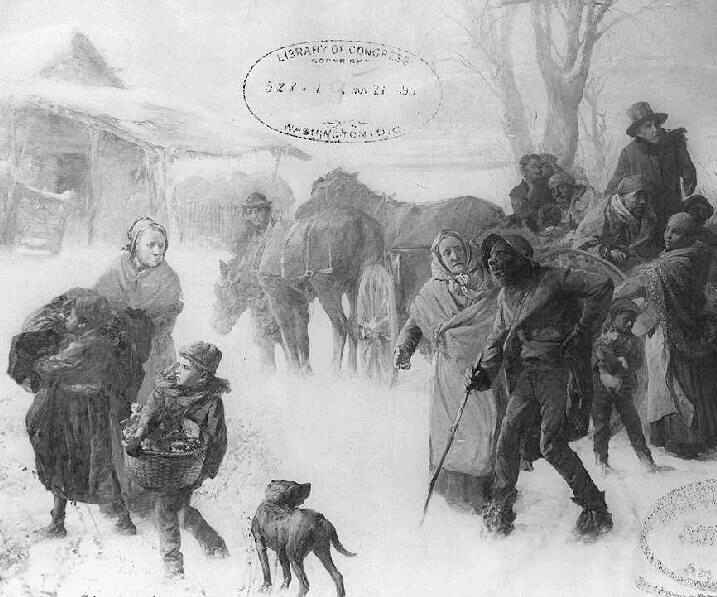
American Slavery: The Underground Railroad

Figure 1.--Here is an idealize image of the underground railroad. The underground railroad did exist, but it was very rare for slave families to reach the north. Young children and the elderly were not up to the rigors of the trek north. Most of the slaves to rech the north were men and women. This is a reproduction of a painting by Charles T. Webber painted about 1893. The original is in the Cincinnati Art Museum. Source: Library of Congress: LC-USZ62-28860
|
|
The Underground Railroad is an icon of American mythology. Many school children are disappointed to learn that there were no locomotives, carriages, and it was not underground. But exist it did and it played a major role, not so much in freeing slaves, but in brining on the Civil War which did free the slaves. The Underground Railroad was a loosely organized and constantly changing network of individuals and families who assisted fugitive slaves reach free northern states and Canada. There was no central organization or organizer so southern and Fderal officials found it impossible to shut down. Recent scholarship suggests that many whites, but mostly blacks (both free and slave) were involved in operaing the Underground Railroad. Many of the whites were reliously motivated. Quakers and evangelical protestants played important roles. The first operations are not known, but as early as 1786 George Washing was complaining about Quakers assisting one of his slaves escape. The term "Underground Railroad" was first used in the 1830s and by the 1840s was a universally used term. At the time the first railroads were just being built and they were the technical wonders of the day. The underground railroad adopted the terminology of the railroads. Stops were stations. Operastors were conductors and the fugaive slaves were the passangers. Many famous people were passangers. The most famous was Frederick Douglas himself. There were no maps or timetables and the whole network oprated with great secrecy. This was necessary because even in the free northern states the Underground Railroad was illegal. Not only could the slaves be seized, but anyone involved in assisting them could be arrested and procecuted. As a result the history of the Underground Railroad can not be documented with any detail by modern historians. No one knows how many slaves were spirited to freedom by the Underground Railroad. Most estimates suggest that the total may reach as many as 0.1 million people between the peak years of the Underground Railroad's operation. [Bordewich] Almost all from the upper-tier border states. Few slaves managed to escape from the deep south slave states. At the same time more slaves were shipped south to the cotton plantations of the deep south than escaped north. Also at the same time the slave population grew from 2.0 to 4.0 million. Some might conclude that the Underground Railroad was a failure. The real impact of the Underground Railroad was to inflame public opinion in the North and South. Slaveholders were furious that northerners would help their slaves escae. They demanded and got Federal legislation to strengthen slave catching operatins in Free northern states which fieled Abolitionist sentiment. This in turn further enflamed southern opinion. The outcome was that by 1860, sectionl sentiment had been fanned to such an extent that political compromise was no longer possible.
Sources
Bordewich, Fergus M. Bound for Canaan: The Underground Railroad and the War for the Soul of America (Amistad, 2005), 540p.
CIH Civil War

Navigate the CIH Civil War Section:
[Return to Main American debate on slavery page]
[About Us]
[Biographies]
[Campaign]
[Causes]
[Emancipation]
[Families and youth]
[Fiscal policy]
[Formations and units]
[Law]
[Railroads]
[Reconstruction]
[Slavery]
[Soldiers]
[Uniforms]
[Weaponry]
[Return to the Main Civil War page]
[Lost Cause]
[Segregation]
[Civil Rights movement]
[Return to CIH Home page]
Created: 6:17 AM 2/4/2006
Last updated: 6:17 AM 2/4/2006



